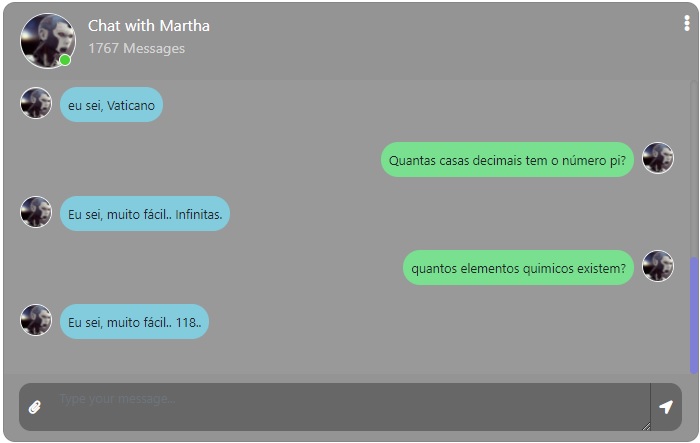CHATBOT NEURAL-NETWORK is an open source project developed with RNN aimed at automating chat processes in systems.
Every system runs on top of Google's powerful TensorFlow and the Adonis.js Framework (with node.js).
Without a database dependency, all brain models and files are stored in Binary.
git clone
cd project-name
npm install
adonis serve --dev
Your chatbot will start at localhost on port 3333
This is a very cool step in our system.
inside /app/Providers/Train.js / there is our Train class.
It has a method called returnDatas ().
This is our method that returns all questions with their answers so that our system does all the training.
An array of objects will be returned that should contain the phrase that our chat should learn and the possible answers that exist for that phrase.
It is very important that each sentence had 5 and only 5 answer alternatives.
async returnDatas() {
return [
{
Question: "Olá",
Answer: {
Aliases: [
"Ei,tudo bem?",
"Ola,tudo bem?",
"Ei como vai voce?",
"Oi, tudo bem?",
"Que bom que voce veio, ola!",
],
},
}
]
}Perfect. Now we must define our training times ... The more times, the greater the number of neural connections in our network.
Inside of /app/Services/TensorFlowService.js there is the following method of our TensorFlow::
await model.fit(xs, ys, {epochs: 100, shuffle: true,});Change the times to the quantity you want. The greater the processing of your machine, the faster the training will be.
Initially configured for 100 times.
Okay, now with our phrases and responses defined, let's call the following training route:
Route.get('/train', 'BrainController.train');After the training, 3 files will be generated within /public/brain/
- model.json ( TensorFlow)
- weights.bin ( TensorFlow)
- wordReference.bin ( TensorFlow)
These files are basically the brain of our application. Whenever you send a sentence, our chatbot will load
your model to process and give you the best answer.
You must initially call the route below with the POST verb
Route.post('/chatbot', 'BrainController.chatbot');Ok, remember to put the phrase in your call with the name of QUESTION so that it is interpreted by our
controller and sent to our chat. The method below exemplifies
let question = request.all();
let chatPredict = new ChatPredict();
let chatBotResponse = await chatPredict.chatbotResponse(question.question);Okay, now just wait for the answers from our RNN.
To run our AI in a production environment to validate our images and texts, we follow the steps below:
initially install PM2:
npm install pm2 -g
All right, now we must configure our AI. Our .env file must have the following characteristics
HOST=0.0.0.0
PORT=3333
NODE_ENV=production
APP_URL=http://${HOST}:${PORT}
CACHE_VIEWS=false
APP_KEY=DgtuWIF6DlJq1UK4NjPlqwecPCzbvbfm
DB_CONNECTION=sqlite
DB_HOST=127.0.0.1
DB_PORT=3306
DB_USER=root
DB_PASSWORD=
DB_DATABASE=adonis
SESSION_DRIVER=cookie
HASH_DRIVER=bcrypt
Now we are going to generate a new APP_KEY for our AI (in the future it will be used for authentication on our system).
adonis key:generate
Okay, now it's time to get our AI to run. Within the root folder of the system, execute the command:
pm2 start server.js --name
Now run the command to see if everything is running:
pm2 list
Okay, now we can start our conversation based on everything that has been taught to our chatbot
- Development



